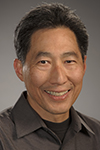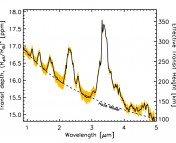In this series of posts, we sit down with a few of the keynote speakers of the 230th AAS meeting to learn more about them and their research. You can see a full schedule of their talks here!
Uncovering the invisible universe one protostar at a time, Erick Young not only studies the infrared (IR) regime but actually helps us see more by building better detectors.
Based in California, Young is a Senior Science Advisor at the Universities Space  Research Association (USRA). His plenary talk “Science Highlights from SOFIA” will be full of IR astronomy news.
Research Association (USRA). His plenary talk “Science Highlights from SOFIA” will be full of IR astronomy news.
Armed with a few lenses and cardboard tubes, Young set out to build his own tools from an early age. The first major project Young worked on, the Infrared Astronomy Satellite (IRAS), was the “very first look at the far IR sky with any real sensitivity”, discovering debris discs around main sequence stars and far IR and ultra-luminous IR galaxies. Post-IRAS, Young helped develop detectors for the Infrared Space Observatory (ISO). Back in the days of ISO, “we were still working with single detectors” and that was standard. Typical IR devices now contain “several thousand [detectors]” which is a huge improvement, but is nowhere near the millions of detectors contained within a typical camera operating at visible wavelengths. SOFIA (Stratospheric Observatory for Infrared Astronomy) demonstrates how far IR instrumentation has developed in the last 40 years, but we “still have a very long way to go”.
Having recently stepped down as the director of SOFIA, Young is hoping to dedicate more of his time to science. Currently he is focused on a guaranteed observation program for the Near-Infrared Camera (NIRCam) situated on the mighty James Webb Space Telescope which is due to be launched late next year. Turning towards clouds that block light even at IR wavelengths, known as dark clouds, Young hopes to use the “high angular resolution and sensitivity of NIRCam to do extinction mapping of the clouds”. IR dark clouds are sites of potential massive star formation and mapping how well light can escape clouds allows for the density profile to be obtained – something crucial for improving our understanding of protostars.
Throughout his “dream career”, Young has mostly been involved in instrumentation with a focus on IR detectors. It is because of this that Young says getting a physics degree is “actually a very good way of going [into astronomy]”. Historically “a large fraction of the IR astronomers were originally in physics because we ended up having to build a lot of stuff ourselves”. ” If someone has that kind of inclination then definitely go for it as departments at various universities are always looking for people who can build stuff”.
Since its first light 7 years ago, SOFIA has studied “a whole range of different astrophysics, things like looking at the dynamics and structure of the star forming regions”. During his talk, Young will “talk about are a number of things that feature the power of SOFIA and in particular the usefulness of the far IR wavelengths”. This includes a velocity resolved map of carbon atoms in the Orion Nebula and observations of Pluto’s atmosphere taken during an occultation. “There are results associated with the occultation of Pluto that take advantage of SOFIA being a mobile observatory. We can place the observatory exactly where we want to catch the center of the shadow and get atmospheric profiles that way”. To hear more about SOFIA and IR instrumentation make sure you attend his 4:30pm talk on Monday 5th June at #AAS230!





Trackbacks/Pingbacks